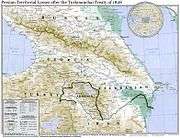Treaty of Turkmenchay
The Treaty of Turkmenchay (Russian: Туркманчайский договор, Persian: عهدنامه ترکمنچای) was an agreement between Qajar Iran and the Russian Empire, which concluded the Russo-Persian War (1826–28). It was signed on 10 February 1828 in Torkamanchay, Iran. The treaty made Persia ceded to Russia the control of several areas in the South Caucasus: the Erivan Khanate, the Nakhchivan Khanate and the remainder of the Talysh Khanate. The boundary between Russian and Persia was set at the Aras River. The territories are now Armenia, the south of the Republic of Azerbaijan, Nakhchivan and Iğdır Province (now part of Turkey).
Long name:
| |
|---|---|
 Northwestern Persian Empire's borders before the treaty of Turkmenchay | |
| Location | Turkmenchay |
| Effective | 22 February 1828 |
| Signatories | |

The treaty was signed for Persia by Crown Prince Abbas Mirza and Allah-Yar Khan Asaf al-Daula, chancellor to Shah Fath Ali (of the Qajar Dynasty), and for Russia by General Ivan Paskievich. Like the 1813 Treaty of Gulistan, the treaty was imposed by Russia, after a military victory over Persia. Paskievich threatened to occupy Tehran in five days unless the treaty was signed.[1]
By this final treaty of 1828 and the 1813 treaty, Russia had finished conquering all the Caucasus territories from Qajar Iran what is now Dagestan, eastern Georgia, Azerbaijan, and Armenia, all of which had formed part of its very concept for centuries.[2] The area north of the Aras River, such as the territory of the contemporary nations of Georgia, Azerbaijan, Armenia and the North Caucasian Republic of Dagestan, were Iranian until they were occupied by Russia during the 19th century.[3][4][5][6][7][8]
As a further result and consequence of the two treaties, the formerly-Iranian territories became part of Russia for around the next 180 years except Dagestan, which has remained a Russian possession ever since. Out of most of the territory, three separate nations would be formed through the dissolution of the Soviet Union in 1991: Georgia, Azerbaijan and Armenia.
Terms

- Article 4: Persia ceded the Erivan Khanate (most of present-day central Armenia), the Nakhchivan Khanate (most of the present-day Nakhchivan Autonomous Republic of Azerbaijan), the Talysh Khanate (southeastern Azerbaijan), and the Ordubad and Mughan regions (now also part of Azerbaijan) and also reiterated the cessions made to Russia in the Treaty of Gulistan.
- Article 6: Persia promised to pay Russia 10 korur in gold or 20 million silver rubles (in 1828 currency).
- Article 7: Russia promised to support Abbas Mirza as the heir to the throne of Persia on the death of Shah Fath Ali. (The clause became moot when Abbas Mirza predeceased Shah Fath Ali.)
- Article 8: Persian ships lost full rights to navigate all of the Caspian Sea and its coasts, which were given to Russia.
- Persia recognised capitulation rights for Russian subjects in Persia.
- Article 10: Russia gained the right to send consular envoys anywhere in Persia.
- Article 10: Persia must accept commercial treaties with Russia as Russia specified.
- Article 13: Prisoners-of-war were exchanged.
- Persia officially apologised for breaking its promises made in the Treaty of Gulistan.
- Article 15: Shah Fath Ali Shah promised not to charge or persecute any inhabitant or official in the region of Iranian Azerbaijan for any deed carried out during the war or during the temporary control of the region by Russian troops. In addition, all inhabitants of the aforementioned district were given the right to move from Persian districts to Russian districts within one year.
The treaty also stipulated the resettlement of Armenians from Iranian Azerbaijan to the Caucasus, which also included an outright liberation of Armenians taken captive by Persia since 1804 or 1795.[9][10] This resettlement replaced the 20,000 Armenians who moved to Georgia between 1795 and 1827.[11]
Aftermath
According to Prof. Alexander Mikaberidze:
Under article 4 of the treaty, Iran ceded sovereignty over the Khanates of Yerevan, Nakchivan, Talysh, Ordubad, and Mughan in addition to regions that Russia had annexed under the Treaty of Gulistan (1813). The Aras River was declard the new border between Iran and Russia. In articles 6-8, Iran agreed to pay reparations of 20 million rubles in silver and transferred to Russia the exclusive rights to maintain a Caspian fleet. In addition, the capitoluratory rights guaranteed Russia preferential treatment for its exports, which generally were not competitive in European markets. In article 10, the shah recognized Russia's right to send consulate envoys to anywhere in Iran. The Treaty of Turkmenchay was the definite acknowledgement of the Persian loss of the Caucasus region to Russia.[12]
According to the Cambridge History of Iran:
Even when rulers on the plateau lacked the means to effect suzerainty beyond the Aras, the neighboring Khanates were still regarded as Iranian dependencies. Naturally, it was those Khanates located closest to the province of Āzarbāījān which most frequently experienced attempts to re-impose Iranian suzerainty: the Khanates of Erivan, Nakhchivān and Qarābāgh across the Aras, and the cis-Aras Khanate of Ṭālish, with its administrative headquarters located at Lankarān and therefore very vulnerable to pressure, either from the direction of Tabrīz or Rasht. Beyond the Khanate of Qarābāgh, the Khān of Ganja and the Vāli of Gurjistān (ruler of the Kartli-Kakheti kingdom of south-east Georgia), although less accessible for purposes of coercion, were also regarded as the Shah's vassals, as were the Khāns of Shakki and Shīrvān, north of the Kura river. The contacts between Iran and the Khanates of Bākū and Qubba, however, were more tenuous and consisted mainly of maritime commercial links with Anzalī and Rasht. The effectiveness of these somewhat haphazard assertions of suzerainty depended on the ability of a particular Shah to make his will felt, and the determination of the local khans to evade obligations they regarded as onerous.[13]
In combination with the 1813 Treaty of Gulistan, some authors have claimed that the two resulting Iranian territorial cessions divided the Azerbaijani people and Talysh people from their brethren in Iran.[14][15][16] As a direct result and consequence of the two treaties, the formerly-Iranian territories became now part of Russia for around the next 180 years, except Dagestan, which has remained a Russian possession ever since. Out of modt of the territory, three separate nations would be formed through the dissolution of the Soviet Union in 1991: Georgia, Azerbaijan and Armenia.
Massacre at Russian embassy
In the aftermath of the war and signing of the treaty, anti-Russian sentiment in Persia was rampant. On 11 February 1829, an angry mob stormed the Russian embassy in Tehran and slaughtered almost everyone inside. Among those killed in the massacre was the newly-appointed ambassador to Persia, Aleksander Griboyedov, a celebrated Russian playwright. Griboyedov had played an active role in negotiating the terms of the treaty.[17]
See also
- Armenia–Iran border
- Azerbaijan–Iran border
- Anglo-Russian Convention of 1907
- Iran-Russia relations
- List of treaties
- Treaty of Akhal
- Treaty of Gulistan
Notes
- Zirisnky, M. “Reza Shah’s abrogation of capitulation, 1927-1928” in The Making of Modern Iran: State and Society Under Riza Shah 1921-1941. Stephanie Cronin (ed.) London: Routledge, 2003, p. 81: “The context of this regime capitulations, of course, is that by the end of the reign of Fath Ali Shah (1798-1834), Iran could no longer defend its independence against the west.... For Iran this was a time of weakness, humiliation and soul-searching as Iranians sought to assert their dignity against overwhelming pressure from the expansionist west".
- Fisher et al. 1991, pp. 329-330.
- Swietochowski, Tadeusz (1995). Russia and Azerbaijan: A Borderland in Transition. Columbia University Press. pp. 69, 133. ISBN 978-0-231-07068-3.
- L. Batalden, Sandra (1997). The newly independent states of Eurasia: handbook of former Soviet republics. Greenwood Publishing Group. p. 98. ISBN 978-0-89774-940-4.
- E. Ebel, Robert, Menon, Rajan (2000). Energy and conflict in Central Asia and the Caucasus. Rowman & Littlefield. p. 181. ISBN 978-0-7425-0063-1.
- Andreeva, Elena (2010). Russia and Iran in the great game: travelogues and orientalism (reprint ed.). Taylor & Francis. p. 6. ISBN 978-0-415-78153-4.
- Çiçek, Kemal, Kuran, Ercüment (2000). The Great Ottoman-Turkish Civilisation. University of Michigan. ISBN 978-975-6782-18-7.
- Ernest Meyer, Karl, Blair Brysac, Shareen (2006). Tournament of Shadows: The Great Game and the Race for Empire in Central Asia. Basic Books. p. 66. ISBN 978-0-465-04576-1.
- "Griboedov not only extended protection to those Caucasian captives who sought to go home but actively promoted the return of even those who did not volunteer. Large numbers of Georgian and Armenian captives had lived in Iran since 1804 or as far back as 1795." Fisher, William Bayne;Avery, Peter; Gershevitch, Ilya; Hambly, Gavin; Melville, Charles. The Cambridge History of Iran Cambridge University Press, 1991. p. 339.
- (in Russian) A. S. Griboyedov. "Записка о переселеніи армянъ изъ Персіи въ наши области", Фундаментальная Электронная Библиотека
- Bournoutian, George. "The Politics of Demography: Misuse of Sources on the Armenian Population of Mountainous Karabakh." Journal of the Society for Armenian Studies, (1996, 1997 [1999]), p. 103.
- Alexander Mikaberidze. Historical Dictionary of Georgia. Rowman & Littlefield, 2015, p. 664. ISBN 978-1442241466
- Gavin R.G. Hambly, in The Cambridge History of Iran, ed. William Bayne Fisher (Cambridge University Press, 1991), pp. 145-146
- "However the result of the Treaty of Turkmenchay was a tragedy for the Azerbaijani people. It demarcated a borderline through their territory along the Araxes river, a border that still today divides the Azerbaijani people." in Svante Cornell, "Small nations and great powers: A Study of Ethnopolitical Conflict in the Caucasus", Richmond: Curzon Press, 2001, p. 37.
- Michael P. Croissant, "The Armenia-Azerbaijan Conflict: causes and implications", Praeger/Greenwood,1998 - Page 67: The historical homeland of the Talysh was divided between Russia and Iran in 1813.
- Swietochowski, Tadeusz. Eastern Europe, Russia and Central Asia 2003 Taylor and Francis, 2003. ISBN 1857431375 p 104
- See Hopkirk, Peter. The Great Game: The Struggle for Empire in Central Asia. New York: Kodansha Globe, 1997, ISBN 1-56836-022-3
Sources
| Russian Wikisource has original text related to this article: |
- H. Pir Nia, Abbas Eghbal Ashtiani, B. Agheli. History of Persia. Tehran, 2002. p. 673-686. ISBN 964-6895-16-6
- Fisher, William Bayne; Avery, P.; Hambly, G. R. G; Melville, C. (1991). The Cambridge History of Iran. 7. Cambridge: Cambridge University Press. ISBN 0521200954.CS1 maint: ref=harv (link)
External links
| Wikimedia Commons has media related to Treaty of Turkmenchay. |
- (in Russian) Text of the Treaty of Turkmenchay